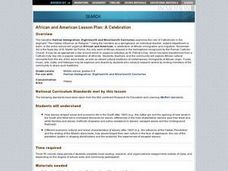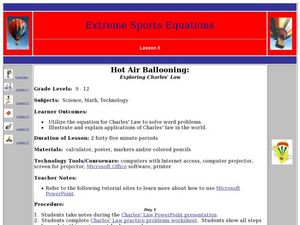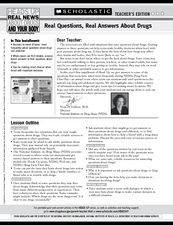Curated OER
Immigration Unit
Third graders develop an appreciate for the various cultures that are present in their local community. Through reading and research, they explain how various culture came to live in their area. At the conclusion of the unit, 3rd...
Curated OER
Money Math Carnival
Third graders explore money in a carnival format. For this money lesson, 3rd graders create a carnival of mathematics activities. Students determine the value of money in mixed amounts and explore how to create representations of money.
Curated OER
History: An African American Cultural Celebration
Students prepare and organize a cultural celebration of African migration and immigration. Working in groups or individually, they research topics and present the information, including dance demonstrations, instrumental or vocal...
Curated OER
Comparing Cultural Holidays
Third graders explore art that reflects their cultural background. In this writing and research lesson students compare and contrast the Halloween with El Dia de los Muertos. Students study the visual art of these holidays. Then students...
Curated OER
United States v. Nixon (1974)
High schoolers examine checks and balances. In this Supreme Court lesson plan, students examine primary documents from United States v. Nixon and discuss the implications of the decision.
Curated OER
Plunge Into Place Value
Students use expanded notation. In this mathematics activity, students determine the place value of a digit within a whole number. Students use manipulatives, words, and symbols to represent whole numbers.
Curated OER
Thomas Jefferson and the Declaration of Independence
Students examine readings and symbols to learn about the War of Independence and Thomas Jefferson. In this War of Independence instructional activity, students explore the role of Thomas Jefferson in the Declaration for Independence....
Curated OER
We the People: Promise and Practice in our Constitution
Students examine the concept that the constitutional government guarantees that our government is not all-powerful and analyze the purposes of our government that are listed in the Preamble. They assess that equality under the law and...
Curated OER
Design an Instrument
Students design an instrument. In this sound, vibration and pitch lesson, students learn about the characteristics of sound, vibration and pitch. Students design a guitar using the assembled craft materials and demonstrate how they...
Manchester University
The History of the First Thanksgiving
First graders complete a project about the first Thanksgiving. In this history lesson plan, 1st graders read The Pilgrim's First Thanksgiving, answer comprehension questions, and complete a booklet about the first Thanksgiving.
Curated OER
AIH-5: Westward Expansion
Fifth graders research how the westward expansion affected the American Indians.
Curated OER
Science As Inquiry
Students practice problem solving through the inquiry approach. They are divided into small groups and given various problems to folve regarding the germination of radish seeds.
Curated OER
Hot Air Ballooning: Exploring Charles' Law
Students solve word problems dealing with Charles' Law. In this Charles' Law lesson plan, students observe PowerPoint presentations concerning Charles' Law. They complete a WebQuest and describe the relationship between hot air...
Curated OER
Texas v. Johnson
Young scholars examine the freedom of speech. In this Supreme Court lesson, students analyze primary documents from Texas v. Johnson and discuss the implications of the decision regarding flag burning.
Curated OER
Math Combinations
Students examine how to use lists, tables, and tree diagrams to solve math combinations. They create various combinations of outfits using clothing manipulatives, watch an episode of the PBS series Cyberchase, and play an interactive...
Curated OER
Phonics and Vegetable Books
Students participate in phonemic awareness and phonics activities and develop a list of vegetable vocabulary words. They break up words into beginnings and endings, and trace and write the letter s. Students then create a Vegetable...
Curated OER
What is a Democracy?
Students identify what makes a country democratic and compare United States and Indian political party symbols. They create their own political party and party symbol. They create a campaign speech, participate in the voting process...
Curated OER
The Gettysburg Address (1863): Defining the American Union
Students explore the Gettysburg Address. In this U. S. history instructional activity, students examine Abraham Lincoln's speech and it's themes of freedom, equality, and emancipation.
Nemours KidsHealth
Diabetes: Grades 3-5
Students investigate personal health by researching healthy eating on the Internet. In this childhood disease lesson, students discuss diabetes, the causes, and ways it can be prevented. Students complete worksheets based on potentially...
National Council of Teachers of Mathematics
Do I Have to Mow the Whole Thing?
In this mowing worksheet, learners find the area of given rectangles. They determine the combinations of lengths and widths that generate a given area. Learners graph given points. This two page worksheet contains sixteen multi-step...
Curated OER
Factor Fun for Fifth Graders
Fifth graders explore common factors. For this factorization lesson, 5th graders discover the greatest common factor among two numbers in a game format. Students build on previous knowledge to determine the greatest common factor.
Scholastic
Real Questions, Real Answers About Drugs
Students brainstorm about questions they have about drugs. In this health science lesson, students research about frequently asked questions on drugs and addiction. They explain why it is important to get accurate information.
PBS
The March on Washington and Its Impact
High schoolers read Martin Luther King, Jr's speech that he gave in Washington. They identify the social conditions that led to the civil rights movement. They discuss the significance of the March on Washington.
Curated OER
CLIMATE AND WEATHER UNIT
Students locate on-line weather source, gathers and interprets weather data, work collaboratively on-line with other schools to collect weather data, and write about the cause of temperature inconsistencies in various locations.

























